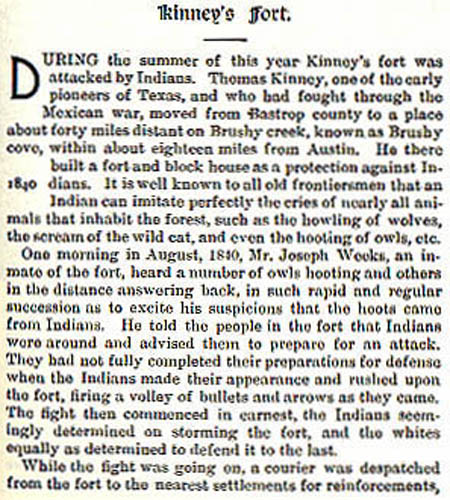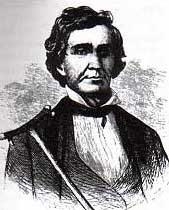
Coleman's Fort Leg
Located adjacent to Kenney's Fort, east of present-day Round Rock, Camp
Cazneau was on Brushy Creek at the Double File Trail Crossing created
by Indians passing through the area. It was used in 1840 by the Travis
Guards and Rifles under the command of George W. Bonnell when he led
raids against the Comanches in May and June of that year.
Marker Title: Kenney's Fort
Address: US 79, 2.5 mi. E
City: Round Rock
County: Williamson
Marker Location: US 79, 2.5 mi. E of Round Rock
Marker Text: 1/2 mile South to the site of Kenney's Fort First
settlement in Williamson County. Erected as a home by Dr. Thomas Kenney
and Joseph Barnhart in the spring of 1839. Served as a place of defense
during Indian raids. Rendezvous of the Santa Fe Expedition, 1841. Here
the archives of the Republic of Texas en route to Washington-on-the-Brazos
were captured on December 31, 1842 and returned to Austin.
In 1840, the Indians raided Kenney's Fort, and a description of the incident appears in the book Indian Depredations in Texas, by J.W. Wilbarger.


The following story
is from the book, The Texas Rangers, by Walter Prescott Webb:
The Rangers were an irregular body; they were mounted; they furnished
their own horses and arms; they had no surgeon, no flag, none of the
paraphernalia of the regular service. They were distinct from the
regular army and also from the militia…

Major Robert McAlpin Williamson
The crutch (pictured above) was needed because he wore a wooden leg
thus the nickname Three-legged Willie. He previously commanded a Ranger
company in 1835 in Col. Moore's battalion. He liked to tell a story
about laying an ambush for some Indians that had been trailing his
company for days. He ordered an extra large camp fire built that evening
and had the men wrap their blankets around logs so it would appear
the whole company was asleep. The Indians attacked their prey with
knives and by the time they realized they were striking wooden logs,
they were wiped out by Ranger gunfire.
The officers of this ranging corps were elected on the night of November
28. The captains were Isaac W. Burton, William H. Arrington, and John
J. Tumlinson. R.M. Williamson and James Kerr were nominated for the
office of major. Williamson was elected. Noah Smithwick served under
Tumlinson and R.M. Williamson, and has left us some account of what
these Rangers did. Texas had an army of five or six hundred men, and
was preparing to invade Mexico. The Indians took advantage of the
situation and began to raid the frontier and murder the citizens.
'So,' says Smithwick, 'the government provided for their protection
as best it could with the means at its disposal, graciously permitting
the citizens to protect themselves by organizing and equipping ranging
companies.'Since Smithwick's account gives such an excellent idea
of the nature of the Rangers' work in this early period, it is given
in his own words. Click on picture below for
his account.

Noah Smithwick
Marker Title: Camp Mabry
Address: W 35th Street, Loop 1
City: Austin
County: Travis
Marker Location: Camp Mabry ground, near W 35th St. entrance
Marker Text: N/A
In 1846, during the Mexican War, a detachment of the 2nd Dragoons of
the U.S. Army was moved from Indian Territory to Austin. Their camp,
like many other holding camps at the time had no name. Two years later,
the camp was named Camp Austin and was more involved with paperwork
than patrols. When the Civil War broke out, the camps arsenal manufactured
cannons and cartridges. Following the Civil War, 26 regiments of Federal
infantry and cavalry were stationed here to restore order in Texas.
Camp Austin at this time consisted mostly of tents with a mess hall,
kitchen, bakery, and quarters. In August of 1875, the camp's garrison
was closed and troops were moved to the frontier. More
In April of 1837 at Fort Coleman, Lieutenant Nicholas Wren and a handful
of men took the company's remuda up the creek to graze. A band of Indians
swept down at a full run, yelling and whistling, stampeding the herd.
A portion of the horses ran toward the fort and Ranger Smithwick opened
the gate. Ranger Felix McCluskey had just mounted his horse at the fort
and took out after the Indians and the rest of the herd. He was joined
by Smithwick who later wrote:
"Old Isaac Castner, who had left the service and was then living
at Hornsby's, had been up to the fort and was jogging along leisurely
on his return. He had crossed the creek and gained the open prairie
when he heard the clattering of hoofs coming in his rear. He turned
in his saddle and took one look behind. The frightened animals pursued
by McCluskey and myself were bearing right down on him. We had lost
our hats in the wild race, and our hair flying in the wind gave us
much the appearance of Indians. Uncle Isaac, who, as previously stated,
weighed about 200 pounds, laid whip to his horse, which was a good
animal, and led off across the prairie to Hornsby's Station, about
a mile distance, the horses following in his wake and we trying to
get in ahead of them. McCluskey's sense of fun took in the situation.
"Be Jasus," said he, "look at him run!" and the
reckless creature could not refrain from giving a war whoop to help
the old man along.
Hearing the racket, the men at Hornsby's fort ran out, and seeing the
chase, threw the gate open. Breathless from fright and exhaustion, Castner
ran in, gasping, "Injuns.""
On the 28th of April, the Indians raided Fort Smith's remuda on the
Little River, escaping with an even larger portion of Captain Daniel
Monroe's Rangers horses but Lieutenant Wren was singled out to be reprimanded
by President Houston for allowing his horses to graze outside the fort
without mounted guards. An early valuable lesson not forgotten by later
Rangers.
Colemans Suffer Indian Attack February 24, 1839

Fort or Camp Coleman, also Fort Colorado
After Texas gained its independence, Sam Houston authorized the formation
of Texas Rangers and the establishment of blockhouses to protect settlers
from Indian attacks. Two facilities were near Austin in 1836. The Texas
Rangers established Camp Coleman, or Fort Colorado, as it would later
be called. It was on high ground above the north bank of the Colorado
River just west of Walnut Creek and six miles southeast of Austin in
present-day Travis County. Built during 1836 by Colonel Robert M. Coleman,
it was first garrisoned by two companies of his battalion. Lieutenant
William H. Moore was the last commander of the fort when it was abandoned
in April 1838. There are no remains of the blockhouse, abandoned as
the frontier moved westward.

Colonel Robert Morris Coleman
Coleman wrote to Senator Sterling Robertson on October
16, describing Fort Colorado and the deployment of his new ranger battalion.
I have selected the most beautiful site I ever saw for the purpose.
It is immediately under the foot of the mountains. The eminence is
never the less commanding, and in every way suited to the object in
view.
I have ordered Capt. Batton to build a block house at or near Milam,
where he will station one half of his company. The other half of the
company under the 1st Lieut. is also ordered to build a block house
at, or near, the three forks of the Little River. I shall in a short
time commence a block house at the head of San Marcos, and one at
the crossing of the Guadalupe, by which means I hope to be able to
give protection to the whole frontier west of the Brazos.
May 14th, 1836, a band of ten to fifteen Comanches carrying a white
flag approached men working in the Hornsby's field. John Williams and
Howell Haggard were speared and shot down. The other men took cover
and the Indians eventually decided against another attack and departed
with a hundred head of cattle from the neighborhood.
A portion of the above fort and camp information is from the book,
Texas Forts, by
Wayne Lease. |